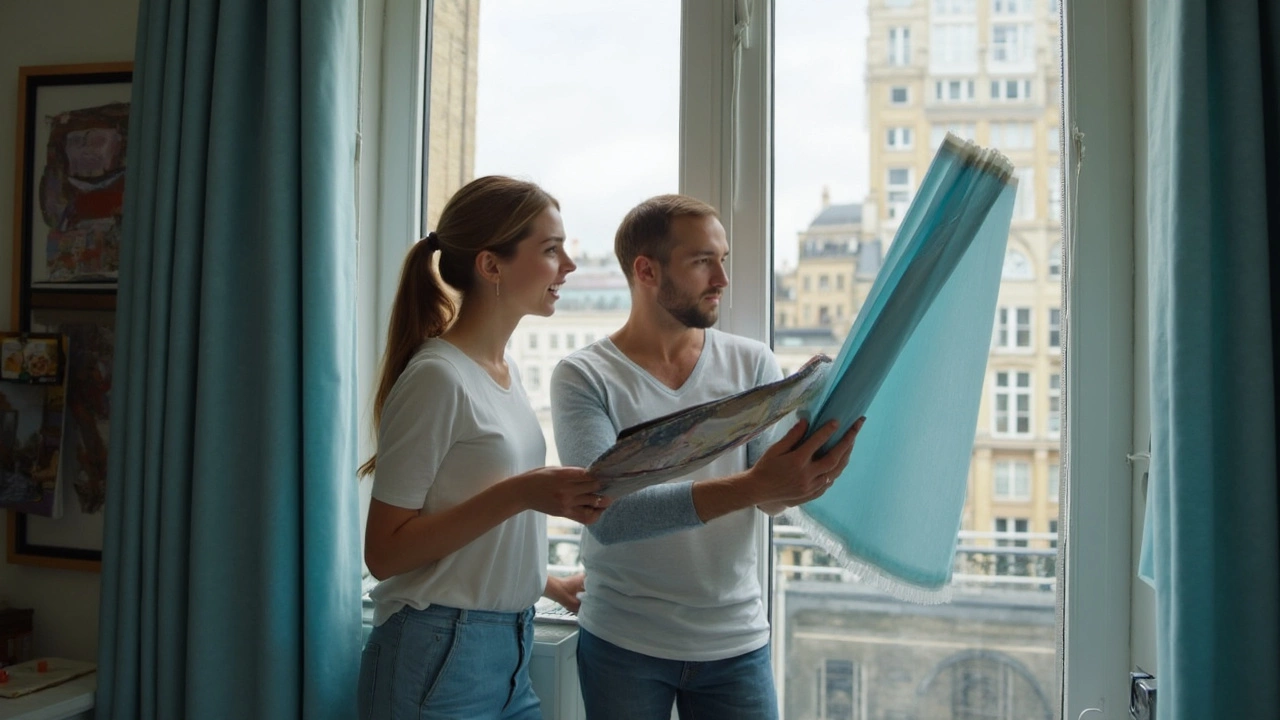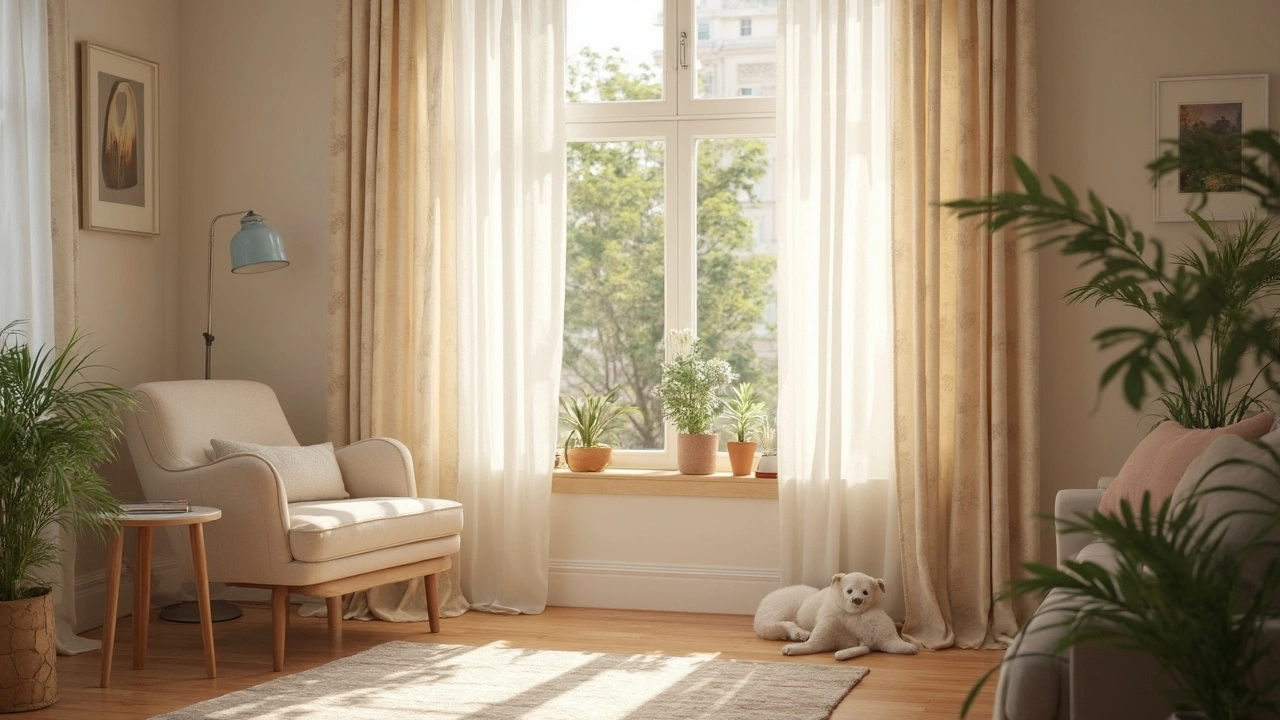If your room feels like it's closing in, your curtains might be making it worse. Lots of people think any neutral or pale curtain will do the job, but there's a smart way to actually make your space look bigger—no renovation needed. It all starts with color, but also what you pair it with and where you hang them.
Light colors are the secret weapon. Off-whites, soft grays, gentle blues, and even pale blush tones can make your space feel open and airy. They bounce light around the room instead of soaking it up. Ever noticed how white walls look like they've just doubled your living room? Light curtains pull the same trick, but without the mess of paint.
But here's what most people miss: it's not just about picking any pale fabric from the shelf. The right shade should match your wall color closely. This helps the curtains blend in, creating a smooth visual line. No harsh breaks, no heavy boundaries, just a room that feels stretched and uninterrupted.
- Why Curtain Color Matters for Small Spaces
- The Best Curtain Colors for a Larger Look
- Sheer and Light Fabrics: More Than Just Color
- Curtain Placement Tricks to Fake More Space
- Common Mistakes That Shrink Your Room
- Quick Tips and Creative Ideas
Why Curtain Color Matters for Small Spaces
Color has a sneaky way of changing how we see space. In a tight room, dark or bold curtain colors can absorb light, making things feel enclosed and cramped. On the flip side, pale and neutral curtain colors like white, light grey, or soft pastels reflect natural and artificial light, giving the impression of more room to breathe. If you want your space to instantly feel bigger, curtain color is one of the fastest fixes.
Here’s something decorators love: curtains are basically a wall's best friend. If you match your curtain color to your wall color, the border between them practically vanishes. It’s a visual trick that makes your room’s lines look longer and smoother. Harsh color differences—like deep red curtains on pale cream walls—have the opposite effect. They chop up the space visually, making corners and windows stand out in a way that shortens the room.
It’s not just about the paint, though. Lots of tiny city apartments use natural light to their advantage, but if the only window is draped in heavy, navy curtains, it can waste all that brightness. Lighter curtains boost the sunshine, making even dark seasons less gloomy. The way you choose curtain colors is kind of like picking the right shirt for a photo—light shades brighten things up, dark ones draw focus and can make you look boxed in.
To really see the difference, check out this quick table comparing light vs. dark curtains in small rooms:
| Feature | Light Curtains | Dark Curtains |
|---|---|---|
| Room Feel | Open, airy | Cozy, but smaller |
| Light Reflection | High | Low |
| Best For | Small and low-light rooms | Large or very bright rooms |
If you’re looking for ways to make a small space appear bigger, you really can’t ignore what curtain color does. In the smallest rooms, even swapping out drapes can feel like instant magic.
The Best Curtain Colors for a Larger Look
If you want to make your space feel bigger with just a curtain color switch, you’ve got to go for light and muted shades. These aren’t just pretty—they actually have a job. Lighter colors like bright whites, creams, pale greys, and soft pastel hues reflect sunlight. This tricks the eye into thinking there’s more open space beyond your windows. Interior designers go for these tones because the science just works: the more light is bounced around, the less cramped your space feels.
Matching your curtain color to your wall is another power move. When there’s little contrast, your eyes won’t bump into awkward edges or lines. It sort of blurs the corners, making the walls look like they go on forever—even if you live in the world’s tiniest studio.
- White and Off-White: These shades lift dark corners and create a classic, airy look that pairs with anything. If your walls are light, these are a safe bet.
- Light Gray: Not as stark as white, but still fresh. Light gray curtains can also hide smudges and dust, which is practical if you don’t want to wash curtains every few weeks.
- Soft Blues: Colors like sky blue or light aqua bring a cool, breezy vibe. Designers often use these in bedrooms to make them feel restful and roomy.
- Pale Greens: Think sage or mint. These soothing colors bounce light but don’t overpower a space, so your room doesn’t end up looking neon.
- Blush or Peach: If you like a warmer look, try pale blush or peach. They keep things open but add just a touch of color.
If you’re deciding between patterns or solid colors, solids are usually safer for a make room look bigger hack. Large patterns can chop up a room’s flow, while plain curtains help stretch out your walls visually.
| Color | Why It Works |
|---|---|
| White/Cream | Maximum light reflection, timeless feel |
| Light Gray | Softens the room, hides dust, modern look |
| Soft Blue | Cools down a space, enlarges sight lines |
| Pale Green | Freshens, adds light, calm effect |
| Pale Blush | Warmth without darkness, gentle on the eyes |
Just remember, the aim is to blend, not jump out. Harmonizing your curtain and wall color does more for small rooms than any fancy pattern ever could.
Sheer and Light Fabrics: More Than Just Color
Picking the right curtain color helps, but don't stop there. The type of fabric you choose can totally change how your room feels. Heavy, dark curtains can eat up daylight and make your walls feel like they’re closing in. Sheer and light fabrics, on the other hand, work like a charm for making things look airy and open.
Sheer curtains let in natural sunlight while still giving you some privacy. That added daylight bounces off pale walls and floors, making the space look almost twice as big. If you’re dealing with a tiny living room or a small bedroom, swapping those thick drapes for sheers can actually make your space feel less claustrophobic.
Lots of interior decorators swear by cotton, linen, voile, and polyester sheers. These materials are light and won’t block out all the sun. Plus, they drape well and always look fresh. If you’re worried about privacy, double up with a sheer base layer and a lightweight solid color on top for nighttime.
Here’s a quick table showing how different curtain fabrics affect a room’s vibe:
| Fabric Type | Effect on Room Size | Light Filter |
|---|---|---|
| Sheer (Voile, Polyester Sheer) | Makes room look bigger | High, lets in lots of light |
| Linen or Cotton | Visually lighter, not bulky | Medium to high, soft light |
| Velvet or Brocade | Makes room look smaller | Low, blocks most light |
If you want to nail that look of a bigger room, stick to sheers or any lightweight fabric in a light color—think off-white, pale gray, or soft beige. Let those light curtains stretch from ceiling to floor so your space feels taller, too. And don’t be afraid to try semi-sheer patterns. Sometimes a little texture can make your curtains more interesting without weighing them down.
Mixing light color and sheer fabric is your best shot for an open, breezy feel in any small space. Not only do these options let in light and make your room look bigger, they’re also easier to keep clean and switch up whenever you want a quick refresh.

Curtain Placement Tricks to Fake More Space
If you're trying to make a small room feel bigger, where you hang your curtains matters just as much as what color they are. Hanging curtains low and tight to the frame? That just drags the whole room down. But with a few adjustments, you can stretch those walls up and out—no construction needed.
The biggest game-changer: mount your curtain rod close to the ceiling. Even if your windows don’t go that high, the trick is to mount the rod about 4-6 inches from the ceiling, or even just under crown molding. This guides the eye up, making ceilings feel taller and the whole space more open.
- Go wide with your rod: Extend it 8-12 inches past the window frame on each side. This lets your curtain color cover the wall, not the window. More glass shows, more light floods in, and everything feels roomier.
- Let curtains just kiss the floor: If your curtains are too short, it chops up the wall visually. Let them at least touch the floor, or even pool slightly for a relaxed look.
- Skip bulky tiebacks: Hard tiebacks and chunky hooks can break up the flow, drawing attention to the window edges instead of keeping things seamless.
Need proof this works? A 2023 survey by a major home decor brand found that rooms with curtain rods mounted just below the ceiling were rated 18% more spacious-looking by viewers compared to the same setup with rods mounted right above the window. Small detail, big impact.
Also, keep your curtain color consistent with the wall for a real magic trick—especially when you’re using light, bright colors. The line between wall and fabric just blurs away, instantly faking a bigger space.
Common Mistakes That Shrink Your Room
Picking the wrong curtain color is an easy way to accidentally make your space look smaller. Dark curtain shades, like navy, forest green, or charcoal, soak up light and draw the walls in. That’s the opposite of what you want if you’re going for an open look. When your curtain color is way darker than your walls, the contrast stands out and chops up the space visually. The room feels boxed in, even if it’s spotless.
Another slip-up is picking heavy, thick fabrics like velvet or heavy blackout drapes. Not only do they block sunlight, but they hang bulky, which makes your windows look more cramped. Pair that with bold patterns or busy prints, and you’ve got curtains doing zero favors for your room’s size.
Where you hang your curtains matters just as much. Curtains that stop at the windowsill or hang too low actually shorten your walls. Designers agree: hanging your curtain color all the way from just under the ceiling down to the floor fakes taller walls and boosts space.
- Poor color match – Curtains that clash with your walls break up the room.
- Heavy fabrics – Bulky drapes make windows (and rooms) feel squashed.
- Short curtain panels – They interrupt those vertical lines that help rooms look taller.
- Thick linings – These block natural light that makes spaces seem bigger.
According to a survey by a popular home improvement magazine, about 57% of people with small rooms said swapping to lighter, longer curtains instantly made their space feel larger. The right curtain color and placement go a long way in tricking the eye into seeing more space than there really is.
Quick Tips and Creative Ideas
Ready to make your space look way bigger using only your curtain color and a few simple tricks? Check this out:
- Match curtain color to your walls: Using similar shades—like pale gray curtains on light gray walls or creamy white on white—makes the whole room feel seamless. Major bonus, your curtains don't grab attention, which visually stretches the walls.
- Hang curtains high and wide: Install your rod a few inches below the ceiling and let those panels go wider than your window. It pulls up the eye and makes both ceilings and windows look bigger. Designers swear by this move for tight rooms.
- Pick light curtain fabrics: Sheer and natural cottons add a breezy vibe. People notice the light, not the boundary of the fabric, so everything seems further away.
- Keep patterns simple, or skip them: Busy prints break up the space. If you absolutely need pattern, go for subtle stripes running top to bottom—vertical lines add height.
- Use tiebacks during the day: Let in max sunlight and push curtains to the side. The more light bouncing around, the bigger and fresher everything looks.
- Layer up: Try layering a sheer panel behind a solid light curtain for flexibility. You can filter light or block it, but never make the window feel heavy or crowded.
Here's a quick cheat sheet showing what colors give your room the most open feel, based on real home stagers' picks:
| Curtain Color | Best For | Effect on Room |
|---|---|---|
| Soft White | Most wall colors | Makes space look clean and bright |
| Pale Gray | Modern, neutral rooms | Adds a cool, airy vibe |
| Light Beige | Warm, cozy spaces | Blends for a relaxed, spacious look |
| Soft Blue | Bedrooms or living rooms | Brings a calm, open feeling |
| Blush | Kids’ or creative spaces | Adds light, keeps things playful |
If you've got a small room, the right curtain color and hang method together really do work wonders. Try any of these ideas, and you'll probably notice an instant difference—even before you move your furniture around.


